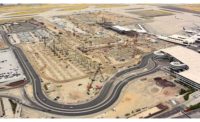After years of spectacular gains, design-build revenue flattened out in 2001 for the ENR Top 100 Design-Build Firms. Part of the reason for this lack of growth has been a softening in the manufacturing, petroleum and industrial process markets, along with a fall-off in the commercial building markets in many areas around the country. But now, design-build is taking aim at new markets.
The Design-Build Institute of America is attempting to open up new markets for design-build around the country. "We are going for targeted outreach for specific markets around the country," says Jeffrey Beard, CEO of DBIA. "We started three years ago, targeting transportation, and have made real progress on that front," he says. The next target will be educational facilities. "We will be having a conference in San Diego this December to try to reach out to local school districts to show how design-build can work for them," Beard says.
 |
| (Illustration by Guy Lawrence for ENR) |
Ransom says that the market for healthcare facilities is looking pretty healthy over the next five years. He notes that design-build is being used widely on smaller rural hospitals designated as critical access facilities that will provide both in-patient and out-patient services. But Erdman also has had success on larger medical projects. It currently is working on a $70-million integrated hospital and surgery center in Naples, Fla., for the Cleveland Clinic and a $47-million hospital addition and medical office building for the Northwest Community Hospital in North Arlington, Ill.
But the commercial office market is not as healthy and promises to give design-build firms some pain. "In the speculative market, there is going to be a need for some vacant space to be burned off before it takes off again," says John McKenzie, vice president of construction for Opus Northwest. McKenzie admits that this has caused Opus' revenue to be off a little. "But we are fortunate that we have several major built-to-suit projects," he says. Opus is building a new corporate headquarters for Best Buy and a $60-million office for U.S. Bank, both in Minneapolis.
The university market also is providing opportunities in design-build. "We are seeing some design-build in university housing," says Bob Fortune, vice president of BBL Construction Services. "That may be because housing is not too complicated and you can present enough of the design so clients are comfortable in knowing what they are getting." Fortune says that BBL is doing a fair amount of student housing work in the Northeast but points to other opportunities throughout the country.
Another company that is enjoying design-build success in the multi-unit housing sector is Swinerton. "There's a lot of work in university housing and military housing," says Jeff Hoopes, executive vice president. But he also cautions that a lot of what is being called design-build is actually something else. "Design-build has become something of a bandwagon, but probably most owners don't understand what they are getting," he says. "What they are really providing is a form of bridging rather than a true design-build."
Swinerton is winning major design-build projects, including the $80-million NORAD U.S. Space Communication Headquarters at Peterson Air Force Base in Colorado Springs, Colo., and the $60-million Memorial Student Center at the University of Arizona.
The public sector has become the brave new world for design-build. There are legislative breakthroughs that are aiding public sector design-build procurement. Arizona now has opened up much of its public sector market to alternative project delivery, "although most public projects are going to construction management/general contracting or CM-at-risk," says Hoopes.
Minnesota also has passed special legislation to allow design-build to be used on state projects, the University of Minnesota and the state college system, says McKenzie. So, as the market in the private sector has softened, the public sector, slowly but surely, has moved forward to fill that gap.


Post a comment to this article
Report Abusive Comment